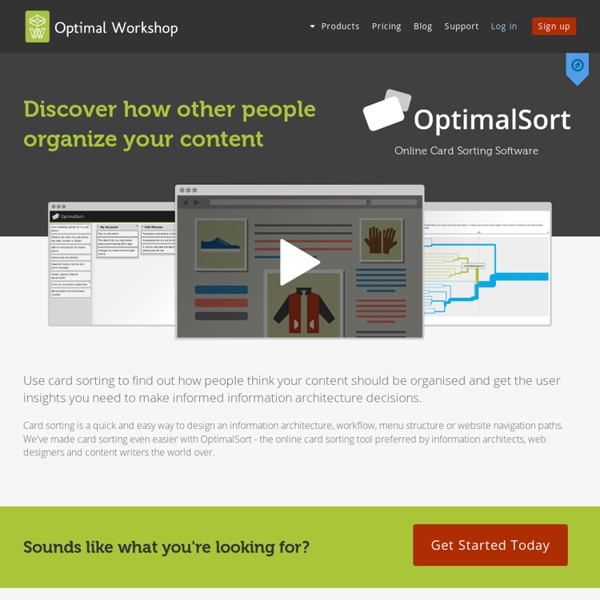



Treejack | Optimal Workshop Information Architecture Validation Software Take the guesswork out of information architecture with Treejack – the usability testing tool you can use to test your IA without visual distractions. Treejack helps you prove your site structure will work before you get into interface design. Tree testing is a usability technique for evaluating the findability of topics in a website. It’s also known as ‘reverse card sorting’ or ‘card-based classification’. Easy as 1,2,3 “It is so fast and easy to set up that it's really crazy not to use it.” – Jason Holmes, American Greetings Proving an Information Architecture 1. Your “tree” is the site structure, your information architecture. 2. We're here to find out if people can achieve what they came for on your website or intranet. 3. We give you a unique study link that you can email to your users and customers, tweet to the world, or give to a participant recruitment agent or consultant. All systems are Go “Oh yes. User Centered Information Design Sign up
Programma's draaien vanaf USB stick Color Name & Hue - Iceweasel It is always a problem for me to assign a certain color to a main hue. If you struggle also with this because of your color blindness, Color Name & Hue might help you. Try it out. With this little tool you can either enter RGB (Red-Green-Blue) values, HSB (Hue-Saturation-Brightness) numbers or a hexadecimal code for a color, to find its closest match of a named color and its corresponding hue. It is also possible to just use the sliders to see how color hues are changing. The list of colors comprises 1640 different color names extracted from several sources on the web. The color name is matched to one of the following main color hues: Red, Orange, Yellow, Green, Blue, Violet, Brown, Black, Grey, and White. I always wanted to have such a tool because it’s fascinating for me to see matching color hues of colors I just can’t categorize. Thanks Chirag Mehta for Name that Color and letting us use his JavaScript code. I tried to check the color hues as good as possible.
Clue – A fun and easy way to test what people remember on your website. Allwetterzoo Münster Keynote Visitor Insights is a feedback tool that lets you not only listen to your customers, but convert that conversation into business intelligence. Harnessing the voice of the customer provides critical insights that you use to stay ahead of competitors and find opportunity for innovation. Visitor Insights provides a way to measure customer satisfaction, and collect customer opinion on your site, without deflecting them from their intended tasks. Visitor Insights combines the best of customer satisfaction survey software with web analytics providing usable data from virtually any website. With a single feedback tool, Visitor Insights allows you to collect the behavioral and analytical customer satisfaction metrics that allows you to confidently improve the visitor experience on your site. Actionable Reporting – Delivered straight to you – In addition to a powerful, secure online portal, Visitor Insights delivers timely reports of key customer metrics that can be shared across your business.
Yolande Spoelder - Adviseur ICT & Onderwijs Elsevier Model voor Effectiviteitsontwikkeling - Elsevier Opleidingen Werkgevers verwachten steeds meer van hun werknemers. Naast vakkennis worden persoonlijke vaardigheden steeds belangrijker. Daarom zoekt u als werknemer een opleiding die u op dit moment, maar ook in uw toekomstige loopbaan verder kan helpen. Bij Reed Business Opleidingen bent u daarvoor aan het juiste adres. Uw beroepspraktijk als uitgangspunt We zijn ervan overtuigd dat opleiden pas effectief is als de eigen beroepspraktijk het uitgangspunt is. Het opleidingsconcept van Reed Business Opleidingen Reed Business Opleidingen leidt u effectief op doordat we de opleiding laten aansluiten op uw praktijk. De uitgangspunten van onze opleidingen op een rij: Praktijkgericht. Ontwikkeling en uitvoering De ontwikkeling van een opleiding begint bij het herkennen van een leerbehoefte. Bij de uitvoering van een opleiding is de praktijk het uitgangspunt. De volgende stap in het leerproces is het geleerde te oefenen. Een leven lang leren < Terug naar Over ons